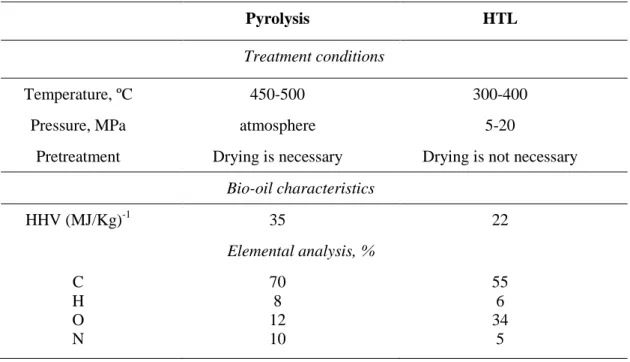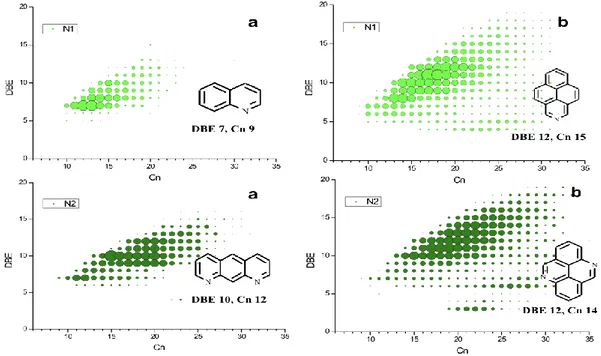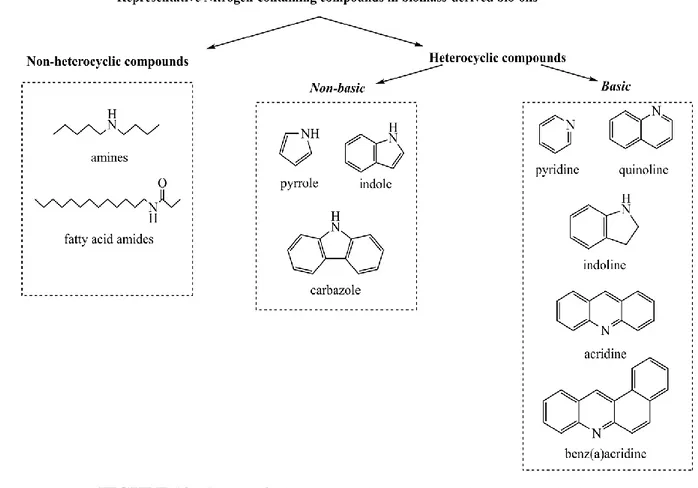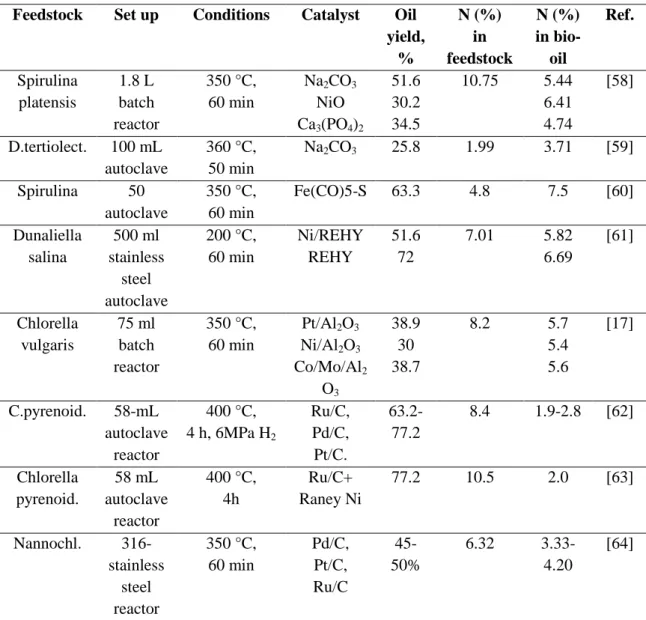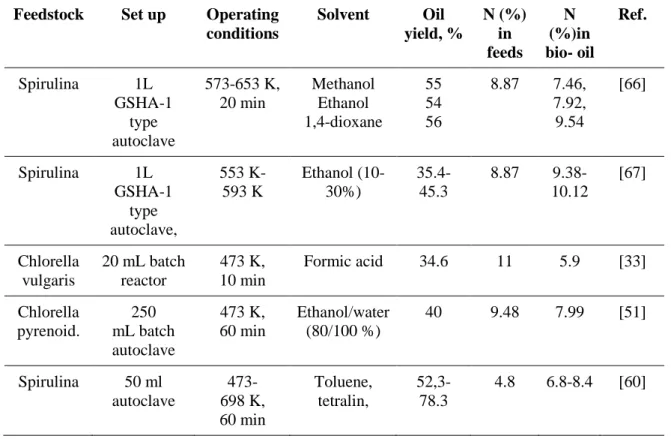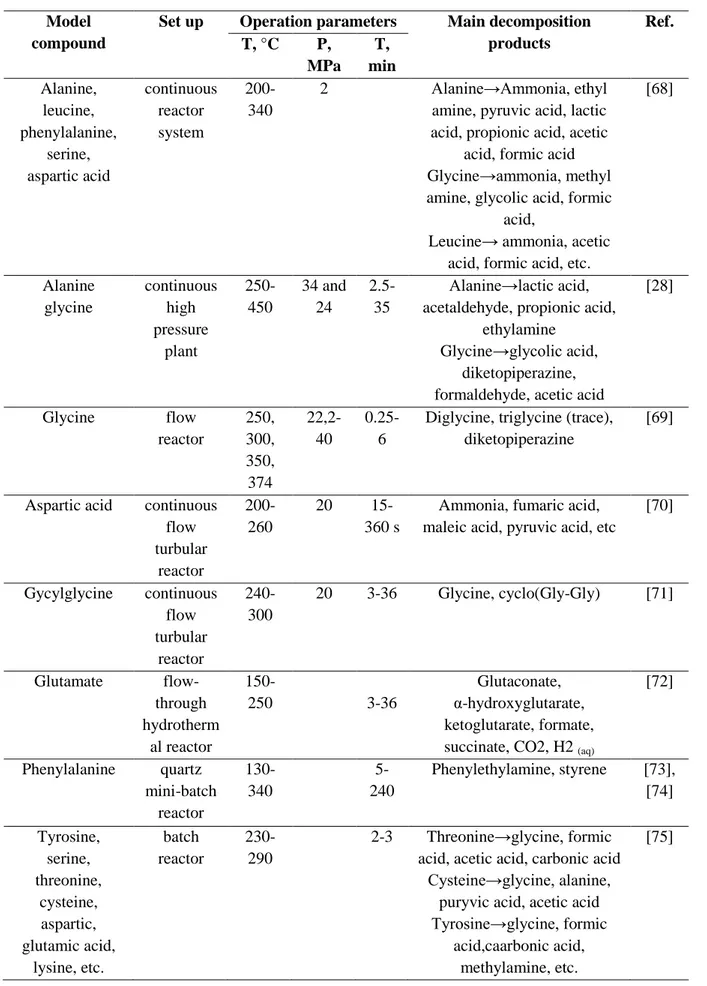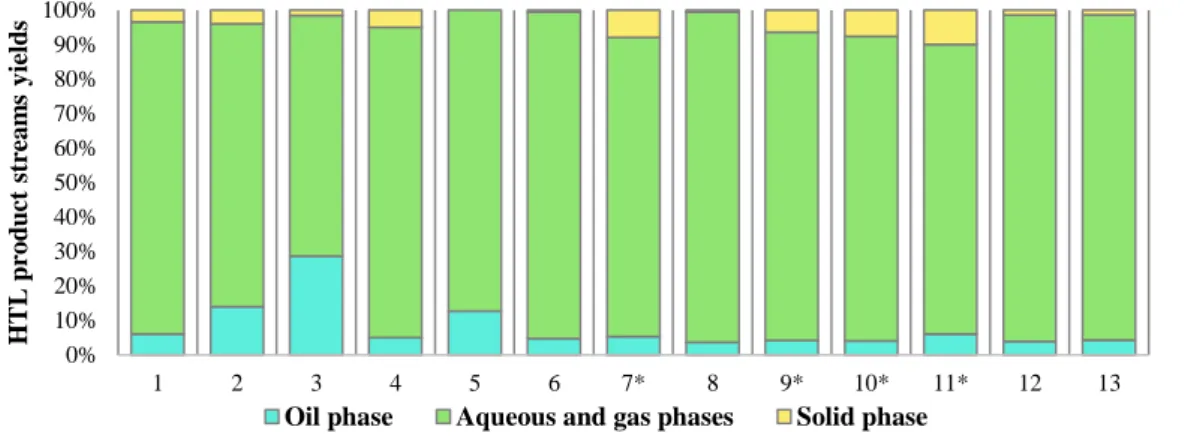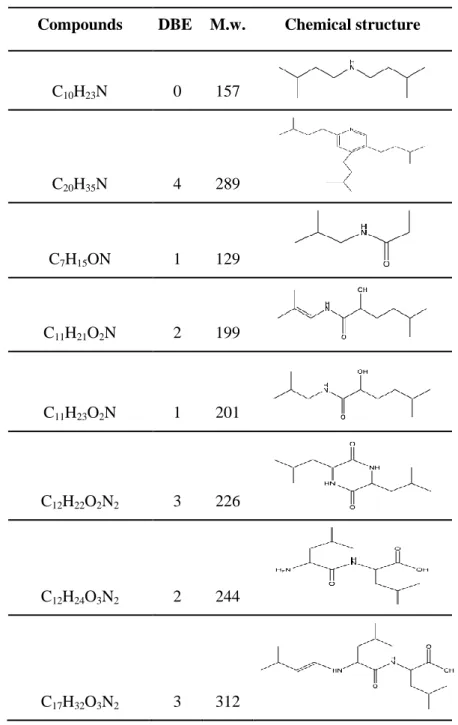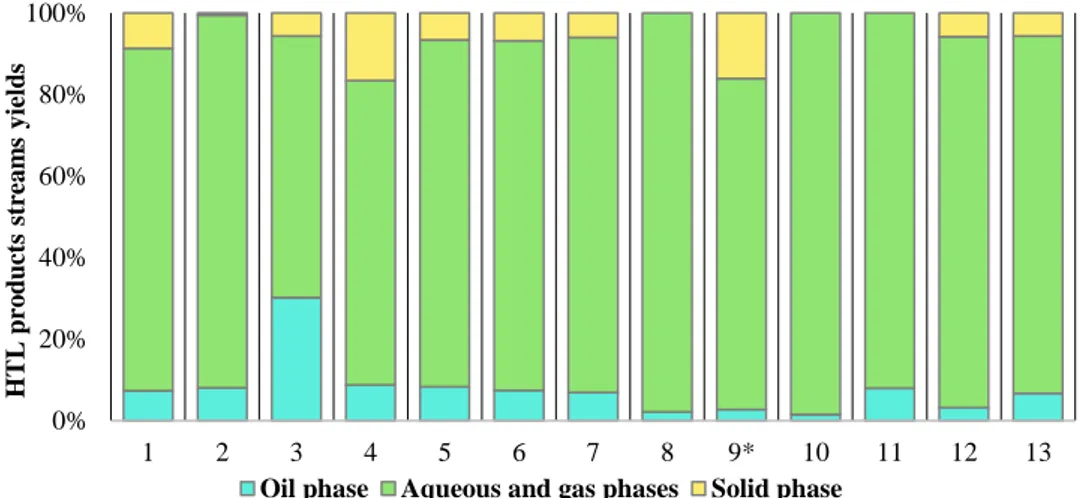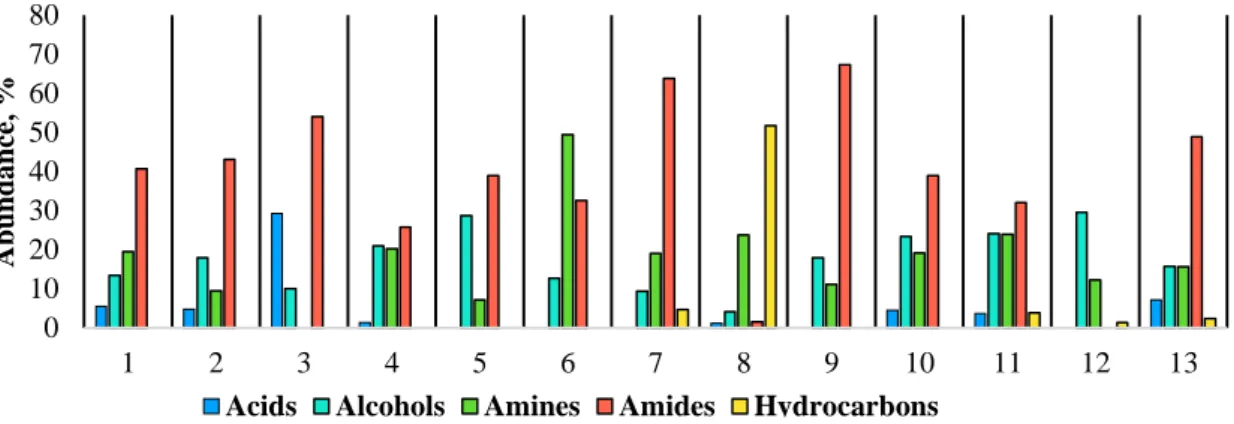DOTTORATO DI RICERCA IN CHIMICA
Ciclo XXXI Settore Concorsuale: 03/C2
Settore Scientifico Disciplinare: CHIM/04
DEVELOPMENT OF INNOVATIVE PROCESSES AND CATALYSTS FOR THE VALORISATION OF BIO-OIL
Presentata da: Aisha Matayeva
Coordinatore Dottorato Supervisore
Prof. Aldo Roda Prof. Francesco Basile
Co-supervisore
Prof. Fabrizio Cavani Dr. Daniele Bianchi Supervisore
Prof. Regina Palkovits
“Development of innovative processes and catalysts for the valorisation of bio-oil”
Der Fakultät für Mathematik, Informatik und Naturwissenschaften der RWTH Aachen University vorgelegte Dissertation zur Erlangung des akademischen Grades einer
Doktorin der Naturwissenschaften
von
M.Sc. AISHA MATAYEVA
ACKNOWLEDGMENTS ... I
LIST OF FIGURES ... II
LIST OF TABLES ... IV
ABSTRACT ... V
CHAPTER 1. INTRODUCTION ... 1
1.1 MOTIVATION:RECOVERING ENERGY FROM WASTE ... 1
1.2 FUNDAMENTALS OF HTL ... 3
1.3 WASTE BIOMASS COMPOSITION ... 4
1.4 DISTRIBUTION OF NITROGEN IN HTL PRODUCT STREAMS ... 6
1.5 CHEMISTRY OF HYDRODENITROGENATION (HDN) ... 7
1.6 ENI SLURRY TECHNOLOGY (EST) UPGRADING OF HTL OIL ... 10
1.7 AIMS AND A ROADMAP OF THE THESIS ... 15
CHAPTER 2. LITERATURE REVIEW ... 17
2.1 EFFECT OF OPERATING CONDITIONS ON THE BIO-OIL YIELD AND NITROGEN CONTENT OF BIO-OIL PRODUCED FROM ALGAE HTL ... 17
2.2 MECHANISM STUDY OF HTL ... 21
2.3 HTL OF MICROBIAL BIOMASS ... 25
CHAPTER 3. EXPERIMENTAL DESIGN AND PROCEDURE ... 29
3.1 HTL OF MODEL COMPOUNDS ... 29
3.2 CATALYTIC LIQUEFACTION EXPERIMENTS ... 33
3.3 HTL OF OLEAGINOUS YEASTS ... 35
3.4 HTL OF LIAMOCINS ... 36
CHAPTER 4. RESULTS AND DISCUSSIONS ... 38
4.1 HTL OF AMINO ACIDS ... 38
4.1.1LEUCINE HTL ... 38
4.1.2PHENYLALANINE HTL ... 47
4.1.3THE EFFECT OF ACETIC ACID IN IMPROVEMENT OF ENERGY YIELDS. ... 55
4.1.4HTL OF PHENYLALANINE IN BINARY MIXTURES WITH TRIPALMITIN AND GLUCOSE ... 60
4.1.5CONCLUSION ... 66
4.2 HTL OF ALBUMIN IN BINARY WITH STARCH AND TRIPALMITIN ... 67
4.2.1BIO-OIL YIELDS, ELEMENTAL ANALYSIS,HHV AND ER OF BIO-OIL PRODUCTS ... 67
4.2.4CONCLUSION ... 80
4.3 CATALYTIC HYDROTHERMAL LIQUEFACTION OF AMINO ACID ... 81
4.3.1HTL PRODUCTS STREAMS YIELDS ... 81
4.3.2HTL PRODUCT STREAM CHARACTERIZATION ... 82
4.3.3CONCLUSION ... 85
4.4 HTL OF OLEAGINOUS YEAST ... 86
4.4.1HTL PRODUCT YIELDS, ELEMENT ANALYSES AND HHV OF ... 86
4.4.2CHEMICAL COMPOSITION OF BIO-OILS ... 87
4.3.3CONCLUSION ... 88
4.5 HTL OF LIAMOCINS ... 90
4.5.1CHARACTERIZATION OF THE LIAMOCINS ... 90
4.5.2CHARACTERIZATION OF BIO-OIL ... 91
4.5.3HTL OF LIAMOCINS ... 94
4.5.4SOLVOLYTIC LIQUEFACTION ... 98
4.5.5CATALYTIC HYDROTHERMAL LIQUEFACTION ... 100
4.5.6PURIFICATION OF LIAMOCINS ... 101
4.5.6CONCLUSION ... 102
CHAPTER 5. CONCLUSION AND FUTURE WORK ... 104
APPENDIX A. SUPPORTING INFORMATION TO SECTION 4.1.4. ... 106
APPENDIX B. SUPPORTING INFORMATION TO SECTION 4.5.3. ... 107
i Acknowledgments
My sincere thanks go to many people who have helped me and supported me through this study. I would like to express my deepest gratitude to my supervisors, Prof. Francesco Basile and Prof. Fabrizio Cavani (University of Bologna, Italy), Prof. Regina Palkovits (RWTH Aachen University), Dr. Daniele Bianchi (Renewable Energy and Environmental R&D Center, Istituto Eni Donegani). Without their guidance, and support, this study would have not been possible.
I am grateful to the SINCHEM consortium members that made possible this European PhD framework. I have enjoyed three wonderful years and have always been feeling that I am living in a big warm family.
I would like to thank all the people at the University of Bologna, the staff, all my colleagues, for their support and help.
I am very thankful to the staff and colleagues at ENI Donegani for their help and support and a great year of working together. Especially, I would like the express my gratitude to Stefano Chiaberge, Mauro Burattini, Silvia Spera, Alessandro Oldani, Manuela Grande for helping me with the performance of FTICR MS, 13C solid state NMR, element analysis, and TOC/TN analyses.
I am very grateful to all my colleagues at RWTH Aachen University for their help and training on science as well as german culture. I would like to thank Elke Biener, Heike Fickers-Boltz, Hannelore Eschmann, Wolfgang Falter, and Simon Petring for performing GC, GC-MS, and HPLC-measurements.
I would like to thank all my friends all around the globe that have encouraged me throughout these years. Finally, to my family in Kazakhstan.
ii List of Figures
Figure 1. Biomass conversion processes ... 1
Figure 2. Phase diagram of water superimposed with different hydrothermal water technologies. Adapted from [13]. ... 3
Figure 3. HDN network of pyridine. Adapted from [61]. ... 8
Figure 4. HDN network of piperidine. Adapted from [42]. ... 9
Figure 5. The HDN reactivity of the types of the nitrogen compounds depending on the severity of the reaction conditions. Adapted from [44] ... 10
Figure 6. Simplified EST process scheme. Adapted from [46]... 11
Figure 7. GC-MS of HTL oil before (a) and after (b) EST upgrading ... 12
Figure 8. APPI+ FTICR MS spectra of HTL bio-oil (a) before and (b) after EST upgrading 13 Figure 9. Cn versus DBE for main N1 and N2 class components in the bio-oil (a) before and (b) after EST upgrading. ... 13
Figure 10. Nature of nitrogen species presented in waste derived oils ... 15
Figure 11. Liamocins structure ... 28
Figure 12. The effect of solvents and catalysts on HTL products stream yields ... 38
Figure 13. The composition of bio-oils from Leucine HTL ... 41
Figure 14. Nitrogen element distribution to products streams of Leucine HTL ... 42
Figure 15. 13 CPMAS NMR analysis of leucine before and after HTL treatment ... 44
Figure 16. Solid residue formation from amino acid HTL ... 44
Figure 17. TOC and TN analyses of aqueous phase ... 45
Figure 18. The effect of solvents and catalysts on the products streams yields of Phenylalnine HTL ... 47
Figure 19. Nitrogen recovery in HTL product streams... 49
Figure 20. The main components presented in the bio-oil from Phenylalanine HTL ... 50
Figure 21. 13 CPMAS NMR analysis of solid residue from Phenylalanine HTL ... 51
Figure 22. TOC and TN analyses of aqueous phase of Phenylalanine HTL ... 52
Figure 23. Chemical pathway of Glutamine HTL ... 54
Figure 24. Distribution of acetic acid into Phenylalanine HTL product streams ... 55
Figure 25. Carbon element recovery in Phenylalanine HTL product streams, % ... 56
Figure 26. Chemical pathway of Phenylalanine HTL ... 57
Figure 27. Cn vs DBE for main class components in the bio-oil from Phenylalnine HTL: a) in water b) water/acetic acid (95/5 % v/v) ... 58
Figure 28. Chemical pathway of Leucine HTL ... 59
Figure 29. Carbon and nitrogen element distributions in products streams of Leucine HTL, % ... 60
Figure 30. Chemical pathway of Phenylalanine/Glucose binary mixture HTL... 62
Figure 31. Alkylated pyrazines in the bio-oil from Phenylalanine/Glucose HTL ... 63
Figure 32. Heteroatoms class components of bio-oil derived from HTL of Phenylalanine/Glucose binary mixture ... 64
Figure 33. DBE versus Cn distributions for N2 and O1N1 class compounds in bio-oil of phenylalanine/glucose binary mixture HTL ... 65
iii
Figure 34. The carbon recovery (CR, %) and nitrogen recovery (NR, %) in the bio-oil ... 69
Figure 35. Heteroatom class components of the bio-oil from Albumin HTL. ... 70
Figure 36. Cn vs DBE plots for the main classes found in bio-oil samples from Albumin HTL ... 71
Figure 37. Heteroatom class components of bio-oil from Albumin/Starch HTL ... 72
Figure 38. Cn vs DBE plots for the main classes found in bio-oil produced from Albumin/Starch HTL ... 73
Figure 39. Reaction pathway of Albumin/Tripalmitin binary mixture ... 74
Figure 40. GC-MS chromatograms of bio-oil samples with a) 20 % triolein content; b) 33 % triolein content ... 76
Figure 41. FTICR ESI+ mass spectrum of bio-oil samples from Albumin/Starch/Tripalmitin ternary mixture a) 20 % triolein content; b) 33 % triolein content. ... 77
Figure 42. FTICR ESI+ based distribution of the main FAAs species as protonated ions... 78
Figure 43. FTICR ESI+ Mass spectrum expansion of the mass range 160-230 Da, specific for N, O-containing alkylaromatic compounds (NAs) a) 20 % triolein content and b) 30 % triolein content ... 79
Figure 44. Main NAs components grouped in classes according to their heteroatom content. a) 20 % triolein content; b) 33 % triolein content ... 79
Figure 45. Product streams yields from catalytic hydrothermal liquefaction of Leucine ... 82
Figure 46. Bio-oil composition from catalytic hydrothermal liquefaction of Leucine ... 83
Figure 47. Aqueous phase composition of catalytic hydrothermal liquefaction of Leucine ... 84
Figure 48. Nitrogen species presented in HTL oil from oleaginous yeast... 88
Figure 49. DBE versus Cn for N2 and O2N1 class compounds in bio-oil products ... 88
Figure 50. TLC of liamocins before and after saponification ... 90
Figure 51. The structure of ML and BHDL ... 92
Figure 52. COSY, HMBC, HSCQ NMR of bio-oil produced form HTL of liamocins ... 93
Figure 53. Reaction pathway of liamocins HTL ... 94
Figure 54. 1H and 13C NMR analyses of ML HTL at 250 °C ... 97
Figure 55. Pictorial view of the solvation of 3,5-DHDA in water and hexane solvents ... 99
iv List of Tables
Table 1. Comparison of two thermochemical processes for bio-oil production ... 2
Table 2. The distribution of nitrogen to products ... 7
Table 3. Bond energies (kJ/mol) for commonly encountered bonds [40] ... 8
Table 4. Summary of studies on catalytic liquefaction ... 20
Table 5. Summary of studies on solvolytic liquefaction... 21
Table 6. Summary of studies on HTL of amino acids ... 22
Table 7. The element analysis, HHV and ER of bio-oils of Leucine HTL ... 40
Table 8. The element analysis, HHV and ER of solid residue of Leucine HTL ... 43
Table 9. Aqueous phase composition of Leucine HTL ... 46
Table 10. The element analysis, HHV and ER of bio-oils of Phenylalnine HTL ... 48
Table 11. The element analysis and HHV of solid residue of Phenylalanine HTL ... 51
Table 12. Aqueous phase composition of Phenylalanine HTL... 53
Table 13. Phenylalanine HTL main product yield and partition ... 58
Table 14. Bio-oil yields, elemental analysis, HHV and ER of bio-oil products from binary mixtures of Phenylalanine/Tripalmitin and Phenylalanine/Glucose ... 61
Table 15. Bio-oil yields, elemental analysis, HHV and ER of bio-oil products from Albumin in binary mixtures HTL ... 67
Table 16. Bio-oil yields, elemental analysis, HHV and ER of bio-oil products of ternary mixture of Albumin/Starch/Triolein HTL ... 75
Table 17. Bio-oil yields, elemental analysis, HHV and ER of bio-oil products of oleaginous yeasts ... 86
Table 18. Chemical composition of bio-oils from oleagineous yeast ... 87
Table 19. Hydrothermal decomposition of liamocins in water... 96
Table 20. Hydrothermal decomposition of liamocins in organic solvents ... 98
Table 21. Hydrothermal decomposition of liamocins in THF ... 99
v Abstract
Hydrothermal liquefaction (HTL) is a process for converting waste biomass to bio-oil by contacting the biomass with water at high temperatures and sufficient pressures in order to keep the water in the liquid state. HTL process has the advantage of being energy efficient and capable of dealing with wet biomass, such as sorted domestic organic waste, sewage sludge, algae, etc.
Despite being a very promising technology economically and environmentally, waste to fuels via HTL has not progressed from pilot scale to industry, primarily due to the issues associated with the recycling of the aqueous phase.
Moreover, waste-derived bio-oil obtained by HTL contains high contents of oxygen and nitrogen because of the initial biomass composition. Therefore, the bio-oil has to be upgraded in order to produce advanced transport fuels.
Information regarding the types of nitrogen compounds present in bio-oil is of major concern of any hydrotreatment, since the low hydrodenitrogenation rate and catalyst poisoning by nitrogen compounds make this process expensive.
Therefore, the main goal of the present study is the investigation of the HTL reaction mechanism, focusing the attention on the nitrogen containing species pathways, with the goal to increase the energy yields and reduce the nitrogen content in the produced bio-oil.
Due to the complexity of the biomass composition, model compounds that encompass all the biochemical components of biomass, namely proteins, lipid and carbohydrates, are emerged to predict important outcomes from HTL of any wet biomass feedstock. Furthermore, several microbial biomass types, such as oleaginous yeast and liamocins, were treated via HTL to produce bio-oil and commercially attractive chemicals.
This work consists of main five parts. In the first part the decomposition behavior of amino acids alone and in binary mixtures with glucose and tripalmitin as representative model compounds of proteins, lipids, carbohydrates, respectively, is investigated. Most attention is paid to the carbon and nitrogen transferring into HTL product streams. Moreover, the effect of homogenous and heterogeneous catalysts, besides the solvents on the HTL product streams is investigated.
The second part includes a comprehensive model study on albumin/starch/tripalmitin mixture in order to mimic a more reliable biomass model and evaluate all the the possible interactions within biomass macromolecular components. Importantly, the effect of biomass composition on the type of nitrogen compounds in the resulting bio-oil is determined.
vi
In the third part deamination of amino acids to produce α-hydroxycarboxylic acids under hydrothermal conditions is investigated in the presence of heterogeneous catalysts.
The fourth part reports a potential application of the HTL process for the production of bio-oils from oleaginous yeasts.
Finally, in the fifth part hydrothermal decomposition of liamocins, another microbial biomass, to produce commodity chemicals, e.g. ð-lactones containing alkyl chains, is reported.
The whole study presented in this thesis helps to better understand the HTL of organic waste biomass and microbial biomass/oils, providing useful insights into the reaction products, pathways, and mechanisms for the production of bio-oils and chemicals.
vii Abstract
La liquefazione idrotermale (HTL) è un processo che produce bio-olio da biomasse di scarto tramite contatto con acqua ad elevate temperature e pressioni sufficienti a mantenere l’acqua allo stato liquido. I vantaggi dell’HTL sono la sua efficienza energetica e la possibilità di trattare biomasse umide, come residui organici domestici, fanghi di depurazione, alghe, ecc. Nonostante sia una tecnologia molto promettente dal punto di vista economico ed ecologico, l’HTL non è stata applicata a livello industriale a causa di problemi legati al riciclo della fase acquosa, che contiene componenti organici solubili in acqua. Inoltre, i bio-oli ottenuti tramite HTL contengono un’elevata quantità di ossigeno e azoto, a causa della composizione delle biomasse di partenza. Quindi, il bio-olio deve essere idro-trattato per produrre combustibili. Per questo motivo sono necessarie informazioni riguardo alle specie di azoto presenti del bio-olio, in quanto queste possono portare a basse rese di idrotrattamento e avvelenamento del catalizzatore.
Quindi, l’obbiettivo principale di questo lavoro è lo studio del meccanismo di reazione coinvolto nell’HTL, con particolare attenzione ai cammini di reazione delle specie contenenti azoto, con l’obbiettivo di incrementare le rese energetiche e ridurre il contenuto di azoto nel bio-olio prodotto.
A causa della complessa composizione della biomassa di partenza, sono stati selezionati componenti modello, come proteine, lipidi e carboidrati, che simulino tutti i bio-componenti presenti nelle biomasse umide. Inoltre, diverse biomasse microbiche, come lieviti oleoginosi e “liamocin”, sono stati trattati con HTL per produrre bio-oli e molecole commercialmente interessanti.
Questo lavoro è composto principalmente da cinque parti. Nella prima, è stata studiata la decomposizione di amminoacidi e di loro miscele con glucosio e tripalmitina, selezionati rispettivamente come composti modello di proteine, lipidi e carboidrati. Particolare attenzione è stata data alla quantità di carbonio e azoto traferiti nei prodotti tramite HTL. Inoltre, si è studiato l’effetto sui prodotti ottenuti di catalisi omogenea ed eterogenea e del solvente.
La seconda parte include uno studio modello su miscele di albumina/amido/tripalmitina al fine di simulare meglio una biomassa e valutare tutte le possibili interazioni tra i componenti macromolecolari di essa. In particolare, è stato determinato l’effetto della composizione della biomassa sul tipo di prodotti azotati nel bio-olio prodotto.
viii
Nella terza parte è stata studiata la deaminazione della leucina per produrre acido α-idrossi-isocaproico in condizioni idrotermali e in presenza di catalizzatori eterogenei.
La quarta parte riporta una potenziale applicazione del processo HTL per produrre bio-oli da lieviti oleoginosi e un confronto con estrazione con solvente in termini di resa e composizione del bio-olio.
Infine, nella quinta parte, è riportata la decomposizione idrotermale del “liamocin”, un'altra biomassa microbica, per produrre prodotti chimici, come ð-lattoni contenenti catene alchiliche.
L’intero studio presentato in questa tesi fornisce una miglior comprensione del processo HTL di residui organici, biomasse microbiche e oli microbici, fornendo utili informazioni riguardo al meccanismo di reazione per la produzione di bio-oli ad alto valore aggiunto e prodotti chimici.
ix Abstrakt
Die hydrothermale Verflüssigung (HTV) ist ein Verfahren zur Umwandlung von Biomasse in Bioöl, bei dem die Biomasse mit Wasser bei hohen Temperaturen und ausreichendem Druck in Kontakt gebracht wird, um das Wasser im flüssigen Zustand zu halten. Die Vorteile des HTL-Prozesses sind die Energieeffizienz und die Fähigkeit mit nasser Biomasse wie sortiertem organischen Hausmüll, Klärschlamm, Algen usw. umgehen zu können.
Obwohl es sich wirtschaftlich und ökologisch gesehen um eine vielversprechende Technologie handelt, ist der Abfall-zu-Brennstoff-Ansatz mittels HTV bisher nicht vom Pilotmaßstab zu industriellen Anlagen übergegangen. Dies ist vor allem auf Frontend-Probleme im Zusammenhang mit dem Recycling der wässrigen Phase zurückzuführen, da diese wasserlösliche organische Verbindungen enthält. Des Weiteren enthält aus Abfällen gewonnenes Bioöl aufgrund der ursprünglichen Biomassezusammensetzung einen hohen Anteil an Sauerstoff und Stickstoff. Daher ist eine Aufwertung des Bioöls nötig, um moderne Kraftstoffe herzustellen.
Informationen über die Art der im Bioöl vorliegenden Stickstoffverbindungen sind bei jeder Behandlung mit Wasserstoff von großer Bedeutung, da niedrige Hydrodenitrogenierungsgeschwindigkeiten der Bioölkomponenten und die Vergiftung des Katalysators durch Stickstoffverbindungen während der Veredelung diesen Prozess teuer machen.
Daher ist das Hauptziel der vorliegenden Arbeit die Untersuchung des HTV-Reaktionsmechanismus, wobei die Aufmerksamkeit auf die Reaktionspfade stickstoffhaltiger Spezies gerichtet ist, mit dem Ziel die Energieausbeute zu erhöhen und den Stickstoffgehalt im produzierten Bioöl zu reduzieren.
Aufgrund der Komplexität der Biomassezusammensetzung werden Modellverbindungen entwickelt, die alle biochemischen Komponenten der Biomasse, nämlich Proteine, Lipide und Kohlenhydrate, umfassen, um wichtige Ergebnisse aus der HTV nasser Biomasserohstoffe vorherzusagen. Darüber hinaus wurden mehrere mikrobielle Biomassearten, wie z.B. ölhaltige Hefe und Liamocin, mithilfe von HTV behandelt, um Bioöl und kommerziell attraktive Chemikalien herzustellen.
Diese Arbeit besteht aus fünf Hauptteilen. Im ersten Teil wird das Abbauverhalten von Aminosäuren in reiner Form und in binären Mischungen mit Glucose und Tripalmitin, als repräsentative Modellverbindungen von Proteinen, Lipiden bzw. Kohlenhydraten, untersucht. Die größte Aufmerksamkeit wird hierbei auf die Übertragung von Kohlenstoff und Stickstoff
x
in HTV-Produktströme gelegt. Darüber hinaus wird der Effekt homogener und heterogener Katalysatoren sowie verschiedener Lösungsmittel auf die HTV-Produktströme untersucht. Der zweite Teil beinhaltet eine umfassende Modellstudie zu einem Gemisch aus Albumin/Stärke/Tripalmitin, um ein zuverlässigeres Biomassenmodell abzubilden und alle möglichen Wechselwirkungen innerhalb der makromolekularen Biomassekomponenten zu bewerten. Bedeutenderweise wird hierbei der Einfluss der Biomassezusammensetzung auf die Art der Stickstoffverbindungen im resultierenden Bioöl bestimmt.
Im dritten Teil wird die Desaminierung von Aminosäuren zu α-Hydroxycarbonsäuren unter hydrothermalen Bedingungen in Gegenwart heterogener Katalysatoren untersucht.
Der vierte Teil stellt eine mögliche Anwendung des HTV-Verfahrens zur Herstellung von Bioölen aus ölhaltigen Hefen dar.
Schließlich wird im fünften Teil die hydrothermale Zersetzung von Liamocinen, eine weitere mikrobielle Biomasse, zur Herstellung von Grundchemikalien wie z.B. δ-Laktonen mit Alkylketten, erörtert.
Die in dieser Arbeit vorgestellte Gesamtstudie ermöglicht die HTV von organischer Abfallbiomasse und mikrobiellen Biomassen/Ölen besser zu verstehen und liefert nützliche Einblicke in die Reaktionsprodukte, Wege und Mechanismen für die Produktion von Bioölen und Chemikalien.
1 Chapter 1. Introduction
1.1 Motivation: Recovering energy from waste
Environmental concerns and possible future shortages have boosted research into alternatives for fossil-derived products [1]. Since 2008, the first European regulations regarding biofuels have been defined in the EU’s Climate Change Package, which aims to achieve the EU climate targets by 2020 [2]:
• 20 % reduction in greenhouse gas emissions • 20 % improvement in energy efficiency
• 20 % share for renewable in the EU energy mix.
The waste organic biomass, such as domestic organic waste and sewage sludge, are highly perishable wet materials with a typical moisture content ranging from 50 to 80 % [3]. They often cause serious environmental problems if not properly disposed. They are also readily available: around 800 million tons of organic wastes are annually produced worldwide [4]. Since these feedstocks do not compete with the food, they can be used for sustainable energy production.
The roadmap for biomass conversion into platform chemicals, which is able to substitute petroleum-derived equivalents, is complex and ranges from biological to severe catalytic thermochemical processes (Figure 1).
2
Organic waste biomass can be converted to bio-oil, which is a precursor for biofuel, by two main thermochemical routes: pyrolysis and hydrothermal liquefaction (HTL). The characteristics and technical feasibility of the two thermochemical processes for bio-oil production are compared in Table 1.
TABLE 1. Comparison of two thermochemical processes for bio-oil production
Pyrolysis HTL
Treatment conditions
Temperature, ºC 450-500 300-400
Pressure, MPa atmosphere 5-20
Pretreatment Drying is necessary Drying is not necessary
Bio-oil characteristics HHV (MJ/Kg)-1 35 22 Elemental analysis, % C H O N 70 8 12 10 55 6 34 5
Several studies have been performed on parallel comparative evaluations of the yields and properties of bio-oil obtained by pyrolysis and liquefaction [5], [6], [7]. In most cases HTL resulted in a higher oil yield with superior properties compared to pyrolysis (except fast pyrolysis).
From a technological point of view, HTL proves to be very energy efficient, as it entails temperatures lower than those reached during pyrolysis [8]. Moreover, pyrolysis requires the feedstock with low moisture content, generally less than 30 % [9], while HTL obviates the drying biomass, thus to leading huge energy savings.
However, HTL is a non-selective process due to the complex composition of the waste biomass, containing polysaccharide, lipid and protein fractions (see Section 1.3). Moreover, there is still no description of chemical pathways to explain the bio-oil formation under hydrothermal conditions. It is very challenging to understand the chemistry of HTL if starting directly from the biomass due to its complex composition To overcome this problem model compounds representing the biomass composition can be used.
3
When initiating this research, there was very little data in the literature on the model studies relevant to the HTL process of waste biomass. Thus, the present study would provide useful insights into the reaction products, pathways and mechanisms for the bio-oil production during HTL.
1.2 Fundamentals of HTL
HTL involves the thermochemical conversion of a broad range of biomass types in the presence of hot compressed water at subcritical conditions into a liquid product known as bio-oil [10]. HTL requires an operating temperature of 300–350 °C at 5–20 MPa for 5–60 min, wherein water is in the liquid form [11]. It produces four phases: a gas-phase, a bio-oil, an aqueous by-product, and a solid residue. Depending on the physical properties (e.g., density and hydrophobicity), the bio-oil is either just gravimetrically separated from the aqueous phase or extracted with an organic solvent [12].
Figure 2 shows temperature/pressure ranges for hydrothermal water processes over the phase diagram of water. Water’s triple point and critical point are shown in the phase diagram; the hydrothermal water processes are typically performed in a narrow window just greater than the vapor-liquid co-existence curve or at pressures slightly in excess of water’s critical pressure (221 bar).
FIGURE 2. Phase diagram of water superimposed with different hydrothermal water technologies. Adapted from [13].
*HTC- hydrothermal carbonization, HTL-hydrothermal liquefaction, SCWU-supercritical water upgrading, c-SCWG-catalytic supercritical water gasification, nc-SCWG-non catalytic supercritical gasification.
4
Subcritical water (<150–374 °C, 0.4–22.1 MPa) and supercritical water (>374 °C, >22.1 MPa) are non-toxic and environmentally friendly media with good mass transfer and heat transfer characteristics. The properties of water, such as the density and dielectric constant, can be continuously controlled between gas-like and liquid-like values by varying the temperature and pressure. For example, at a pressure of 25 MPa, the dielectric constant decreases from approximately 78 at 25 °C to 27 at 250 °C and to 2 at 400 °C [14].
This decrease in dielectric constant increases the solubility of small organic compounds. Thus, the polarity of water, and hence its ability to dissolve various solids, liquids, and gases that are otherwise insoluble or sparingly soluble can be significantly enhanced by transforming ordinary water into supercritical water.
In addition, water under subcritical conditions can act as an acid or base catalyst, whereas supercritical water offers the unique possibility of shifting the dominant reaction mechanisms from free radical to ionic through manipulation of the water density [15].
HTL, which mimics the processing of fossil fuels buried deep inside the earth, occurs in minutes or hours. HTL produces oil with lower oxygen content as opposed to other processes like fast pyrolysis. The HTL process begins with solvolysis of biomass in micellar forms, the disintegration of biomass fractions, and thermal depolymerization into smaller fragments. Key parameters affecting HTL process include feedstock types, process modes (batch and continuous), process conditions (temperature, retention time, and pressure), and catalysts.
1.3 Waste biomass composition
The major components of waste biomass can be roughly classified to proteins, lipids, carbohydrates, lignin and ash.
Lipids. The typical composition of sorted domestic organic waste includes a consistent fraction of lipids as mono-, di-, tri-glycerides and free fatty acids ranging from 10 to 35 % [16]. Microalgae also can have lipid contents as high as 80 %, although this is usually in the range of 15-35 % and is dependent on the growth conditions [17].
In hot compressed water, triacylglycerides are readily hydrolyzed to glycerol and fatty acid. During the HTL process, the conversion of glycerol is inclined to produce water-soluble compounds, such as methanol, acetaldehyde, propionaldehyde, acrolein, allyl alcohol, ethanol
5
and formaldehyde, with some gas products, mainly CO, CO2 and H2 [18]. The lipid content is
contributed directly to the HTL oil phase. Therefore, high-lipid biomass produces higher bio-oil yield in comparison to low-lipid biomass.
Carbohydrates. As a major component of waste organic biomass, typical carbohydrate contents range between 10-65 wt.% [19]. For instance, the most abundant carbohydrates in algae are cellulose and starch. In addition, depending on the type of species, hemicellulose as well as various other heteropolysaccharides may also be present [20].
Under hydrothermal conditions, carbohydrates undergo rapid hydrolysis to form glucose and other monosaccharides, which are then further degraded. The main liquefaction mechanism is breaking down of carbohydrates to polar water-soluble organics, such as organic acids (i.e. formic, acetic, lactic), aldehydes, and alcohols, all carrying a substantial amount of oxygen [19], [21], [22]. The aldehyde- and benzene-type structures may further produce larger hydrocarbons, which can be then a part of the bio-crude fraction [19]. The degradation of carbohydrates in hot-compressed water has been comprehensively discussed elsewhere [23].
Proteins. Higher protein content is a primary difference between organic waste biomass and terrestrial biomass [24] that causes a high content of nitrogen in the bio-oil produced by HTL. The protein content is highly dependent on the type of feedstock and can be as high as about 65-70 wt.% for Spirulina [5], [25].
Proteins are polymers of amino acids linked by peptide bonds, which consists of a carbon-nitrogen bond between the carboxyl and amine groups forming long chains [26], which is hydrolyzed in subcritical water [27] to form amino acids. The amino acids can be further converted to amines by decarboxylation and to organic acids by deamination [28]. The degradation products of amino acids may then repolymerize and undergo Maillard-type reactions with the sugars to produce nitrogen heterocyclic compounds, such as indole or pyrroles [29].
Sorted by contributions and tendencies to contribute to the oil yield, the components of biomass are in the following order: lipid > protein > carbohydrate [30]. Although the lipid fraction is typically the main target of oil production, about 1–15 % of the produced bio-oil is converted from carbohydrates and proteins under hydrothermal conditions [22].
Generally, each biomass fraction does not behave independently during the HTL process and their contribution to an overall oil yield depends on an interaction among its components. The
6
information about the reactions of the most abundant types of biomolecules (e.g., proteins, lipids, and carbohydrates) in hydrothermal water conditions is described elsewhere [31]. Although HTL has a positive economic potential due to a favorable energy balance [32], it produces the bio-oil with a significantly higher oxygen and nitrogen contents, typically 10-20% and 1-8 %, respectively, compared to the conventional crude oil (both elements <1 %) [33]. Bio-oil with a high nitrogen content is undesired, as it has poor storage stability, low energy density and unsuitable for direct application as transportation fuels.
1.4 Distribution of nitrogen in HTL product streams
The elemental distribution among the HTL product streams can be used to better understand the reaction mechanism of HTL and provide useful information for the process optimization. The nitrogen distribution is considered less by researchers in comparison to carbon distribution, even though it is one of the main influencing factors for sustainable biofuels. The nitrogen could distribute to gas, oil, aqueous, and solid residue phases during the liquefaction (Table 2).
For most of amino acids, the majority of nitrogen was found in the aqueous phase. Y.F. Yang et. al. [34] found that the total nitrogen concentration in the aqueous phase ranged from 998 to 1157 mg/land half of which was detected as ammonia. Therefore, they proposed recycling the aqueous fraction for algae growth as nutrients.
I. Espinoza-gonzalez et. al. [84] observed that with the temperature increasing from 200 °C to 260 °C, more nitrogen is remained in the bio-oil phase. At higher temperatures ranging from 260 °C to 320 °C a higher amount of nitrogen is released in aqueous fraction or gaseous phase.
Although nitrogen containing gases are not easily detectable in the gas phase, Ross et al. [35] observed that part of nitrogen in algal feedstocks was converted to gaseous products as NO2,
7
TABLE 2. The distribution of nitrogen to products
Feedstock Operating
conditions
Nitrogen distribution, (%) Ref. Gas Oil Aqueous Solid Macroalgae Derb. 330 ºC, 5 min 2 29 65 2 [36] Ulva 0.5 31 66 2.5 Chaet 34 19 40 5 Clad. 11 18 65 5 Oedog. 8 35 55 2 Clad. 10 20 55 5 Microalgae Nannochloropsis sp. 350 ºC, 10 min - 4.3 11 g/l* 3.22 [37] Spirulina platensis 60 min - 6.3 1.91 g/l* 1.61 [5] Protein Albumin 300 ºC - 2.5 84 0 [38] Serine 60min - 2.24 80.5 0 [24] Valine - 3.41 84.3 0 Leucine - 7.09 69.3 0 Phenylalanine - 5.64 84.6 8.4 Tyrosine - 50.5 47.5 1.3
*N concentration in aqueous phase, g/l was calculated by persulfate method
1.5 Chemistry of hydrodenitrogenation (HDN)
Available upgrading techniques for bio-oil include hydrocracking, zeolite cracking, thermal cracking, hydrotreating, etc. Traditionally, cracking reactions (e.g., zeolite cracking) and hydrotreating are two major approaches to upgrade petroleum crude, because they can reform undesired chemicals into hydrocarbons through chemical reactions. Cracking reactions mainly convert heavy molecules into two light molecules, whilst hydrotreating can achieve saturation of olefins, hydrodeoxygenation (HDO), hydrodenitrogenation (HDN) and hydrodesulfurization (HDS).
8
Organic nitrogen is most commonly removed under high pressure of hydrogen (up to 30 MPa) at 600–670 K. The most well-known catalysts for HDN are sulfided NiMo or NiW supported on alumina [39]. Under industrial conditions, HDN is always accompanied by other hydrotreating reactions, such as HYD, HDS, HDO, HDM, hydrocracking, and coking. Since HDN is less efficient compared to HDS, much more hydrogen is consumed. This can be partially explained by a relative bond strength as shown in Table 3.
TABLE 3. Bond energies (kJ/mol) for commonly encountered bonds [40]
Bond Energy, kJ/mol Bond Energy, kJ/mol H-H 436 N-H 391 C-H 413 C-N 308 C-C 348 C=N 615 C=C 614 C≡N 891 C≡C 839 C-S 259 C-O 358 C=S 577 C=O 799 S-H 347
In general, HDN involves the saturation of the aromatic ring followed by hydrogenolysis of the C─N bonds to yield ammonia and the corresponding hydrocarbon (Figure 3) [41].
FIGURE 3. HDN network of pyridine. Adapted from [61].
However, the formation of unsaturated C5 hydrocarbons and ammonia via hydrogenolysis of C-N bonds in the piperidine ring could occur in a lesser extent [42]. Instead, the alkylation of the heterocyclic ring could predominate, resulting in the formation of alkylpiperidines with N-pentylpiperidine (Figure 4). Cyclization reactions resulted in the formation of decahydroquinolines, while dehydrogenation of the latter and of piperidine yielded 5,6,7,8-tetrahydroquinoline and pyridines (tetrahydropyridine and pyridine), respectively.
In other words, during HDN process the formation of secondary nitrogen-containing compounds, which are more resistant to HDN than the original ones, can be observed.
9
More severe catalyst deactivation is caused by the higher molecular weight-aromatic compounds in the feedstock. With increasing the boiling point of the feeds, the size of molecules of nitrogen-containing compounds increases, which reduces their accessibility to the catalyst surface.
FIGURE 4. HDN network of piperidine. Adapted from [42].
Most upgrading techniques have been exclusively developed for petroleum, in which nitrogen is not a concern, and there have been only a few studies on the determination of HDN reactivity of nitrogen compounds in fossil crude oils.
T. Zhang et. al. [43] performed FT-ICR MS ESI analyses for the asphaltenes-free vacuum residue derived from deasphalted oils before and after hydrotreating and classified HDN reactivity of nitrogen compounds as easy- and hard-to convert nitrogen compounds. According to their results, N1 compounds were shown to be more hydrotreatment-resistant than compounds with additional nitrogen and oxygen heteroatoms.
Similarly, H. F. Silver and N. H. Wang [44] investigated the relative rates of disappearance of the types of nitrogen compounds presented in shale gas oil using conventional hydrotreatment Co-Mo on Al2O3 catalyst. At higher temperature (400 °C) the nitrogen removal reached 70%.
According to Figure 5, primary and secondary amines and amides were practically missing in the oil after hydrotreatment, while indole and quinolines type compounds were the most difficult to denitrify.
In comparison to fossil fuels, waste biomass-derived oils usually contain much higher concentrations of nitrogen-containing compounds. They are more complex in structure and
10
more difficult to denitrify. However, till to date no information is reported regarding the HDN reactivity of nitrogen containing components of waste-derived oils.
FIGURE 5. The HDN reactivity of the types of the nitrogen compounds depending on the severity of the reaction conditions. Adapted from [44]
1.6 Eni Slurry Technology (EST) upgrading of HTL oil
Eni Slurry Technology (EST) is a hydrocracking process developed by Eni for the upgrading of very heavy feedstock, such as petroleum residues, extra-heavy oils, tars and bitumen (Figure 6). EST provides higher yields over current available conversion technologies. Moreover, EST offers significant advantages in terms of efficiency of hydrogen utilization and catalyst life, achieving longer cycle length compared to hydrocracking solutions currently being marketed [45].
EST is based on a slightly different concept from that industrially applied in the past. A catalyst precursor, consisting of an oleo-soluble molybdenum carboxylate (i.e. naphthenate or octoate), is dissolved in the feedstock and the mixture is fed to the reactor, which operates in the temperatures range 673–723 K under a total pressure of 15 MPa. H2 is fed through a
distributor located at the reactor bottom. Under these conditions, the catalyst precursor is converted to molybdenite, which is crystalline layered MoS2, with an average particle size of
a few nanometers [46]. 0 18 35 53 70
Feed gas oil 315 370 400
%
Temperature, °C
11
FIGURE 6. Simplified EST process scheme. Adapted from [46]
Recently EST has been tested for the upgrading of bio-oil produced from HTL of organic domestic waste. Interestingly, for the bio-oil upgrading the metal removal (HDM) (>99%), sulphur removal (HDS) (>85%), and oxygen removal (HDO) (>90%) were efficient, while nitrogen removal (HDN) (>65%) was lower in comparison to HDM, HDS and HDO.
In order to identify the most resistant nitrogen-containing compounds, GC-MS and FTICR MS APPI+ were performed for bio-oils before and after EST treatment.
GC-MS allows the characterization of about 50-70 % of the bio-oil and the upgraded product, since nor heavy or polar nitrogen and oxygen containing compounds are amenable for the detection by GC-MS.
According to GC analysis, fatty acids (FA), fatty acid amides (FAA), and fatty acid esters (FAE) were totally removed (Figure 7 a), as a result, the acidity was reduced and nitrogen content was reduced from 4 % to about 1.5 %. As it can be seen from Figure 7 b, after EST upgrading mainly hydrocarbons were presented in the bio-oil, while, nitrogen containing compounds were not eluted in GC spectra.
12
FIGURE 7. GC-MS of HTL oil before (a) and after (b) EST upgrading
Petroleomics by ESI-FT-ICR MS have been shown to allow for class attributions of the thousands of polar compounds present in crude oils and to provide crucial data for the oil industry. Data analysis was able to assign hundreds of formulas, which were grouped in several different classes. Appropriate manipulation of this very large data set via specific plots, such as abundance versus class distribution and DBE versus Cn, permits the identification of patterns and the inference of some important physical and chemical properties of the oil, such as the unsaturation level and aromaticity (DBE= sum of aromatic rings and double bonds). Specific classes can also be observed and semi-quantified. The application of this approach, therefore, allows for a rapid and comprehensive characterization of bio-oil products.
APPI+ FTICR MS analysis showed over 2000 attributed molecular formula for bio-oil and about 2200 molecular formulas for upgraded bio-oil. From normalized data on main classes distribution, Ox class components are drastically reduced after upgrading, while nitrogen is
13
FIGURE 8. APPI+ FTICR MS spectra of HTL bio-oil (a) before and (b) after EST upgrading
From Figure 9 it can be seen that wide distributions for nitrogen containing compounds in the aromatic region are at DBE over 4. More abundant compounds in the bio-oil show DBE of 7-10. In the upgraded oil the most abundant compounds show higher DBE values 8-13, that are likely polyaromatic nitrogen containing compounds (PNAHs). Similar behavior is observed for N2 class components. More abundant compounds in the bio-oil show DBE of 7 and 9-12. In the upgraded oil the most abundant compounds show higher DBE values 10-15 (PNAHs).
FIGURE 9. Cn versus DBE for main N1 and N2 class components in the bio-oil (a) before and (b) after EST upgrading.
200 300 400 500 0 20 40 60 80 100 % R e la ti ve Ab u n d a n ce m/z N1 N2 O1N1 O1N2 O2N1 O2N2 CH 200 300 400 500 0 20 40 60 80 100 % R e la ti ve Ab u n d a n ce m/z N1 N2 O1N1 O1N2 O2N1 O2N2 CH
14
Once again, these data suggest that the EST upgrading process is successful in terms of diesel fraction yield and HDO, HDM and HDS; however, nitrogen is not completely removed. After upgrading, linear saturated hydrocarbons (C14-C30) were the main components of the bio-oil. Regarding petroleomic approach used, the residual nitrogen (1.5 %) is found to be N1 and N2 class components that are attributed to alkylated polycyclic compounds (PNAHs).
To conclude, nitrogen-containing compounds in waste derived bio-oils can be divided into two groups: heterocyclic and non-heterocyclic. Figure 10 lists the various types of nitrogen-containing compounds (without alkyl substitution) presented in the bio-oils. Non-cyclic nitrogen compounds, such as aliphatic amines and FAAs, are easy to denitrogenate. Heterocyclic nitrogen-containing compounds can be divided into basic and non-basic compounds. Non-basic compounds consist of five-membered heterocycles, such as pyrrole, indole, carbazole, etc. Basic compounds include six-membered heterocycles, such as pyridine, quinoline, acridine, etc. The lone-pair electrons on the nitrogen atom of non-basic compounds are delocalized around the aromatic ring and are not available for donation to acid sites on catalyst surfaces. In contrast, the lone-pair electrons on the nitrogen atom of basic compounds are available for sharing with acid sites on catalyst surfaces.
These heterocyclic nitrogen-containing compounds are difficult to denitrogenate during the upgrading. Moreover, six-membered basic heterocyclic nitrogen compounds cause the deactivation of the hydrtotreatment catalysts.
These conclusions are crucial to tune the bio-oil specifications in order to meet the requirements of hydrotreatment process in order to produce advanced transport fuels from organic waste biomass.
15
FIGURE 10. Nature of nitrogen species presented in waste derived oils
1.7 Aims and a roadmap of the thesis
For understanding the degradative phenomena of biomass, which causes the formation of undesirable components (for instance, PNAHs) that are resistant to hydrotreatment, a complete knowledge of the chemical pathway of HTL is required. Therefore, the ultimate goal of this research is to investigate the fundamental mechanisms of HTL, including the elemental transfers during the process, with the emphasis on the nitrogenous species pathways during HTL.
To achieve this goal, the chemical mechanism of HTL of organic waste is extensively investigated starting from monomeric model compounds of protein (leucine, phenylalanine, glutamine) individually and in binary mixtures with carbohydrates (glucose) and lipids (tripalmitin). Then macromolecular model compounds (albumin, starch, tripamitin, triolein) were employed alone and in binary/ternary mixtures to mimic the real feedstock composition.
16
Finally, the real microbial biomass feedstocks were treated under HTL conditions to summarize the results of the modelling study.
This whole work is organized as follows. A review of literature on the effect of operating conditions of HTL on the quantity and quality of bio-oil, and the chemical pathway of some model compounds are presented in Chapter 2. Chapter 3 discusses the experimental setup and the methodology used to carry out quantitative and qualitative analyses. Results pertaining to monomeric model compounds are discussed in Section 4.1. Section 4.2 covers the study on HTL of macromolecular model compounds. The possibility of enhancing the deamination route under hydrothermal liquefaction of leucine is demonstrated in Section 4.3. The work carried out with microbial biomass types, including oleaginous yeast and liamocins is reported in Sections 4.4 and 4.5, respectively. Chapter 5 concludes the key findings of this study, and gives directions for future work.
This comprehensive approach can help to better understand the process of organic waste biomass HTL and can be important for tailoring the waste feedstock composition in order to produce the bio-oil with the high standard quality. The whole study is crucial for the optimization of HTL process applied to protein rich biomass and microbial biomass/oils.
17 Chapter 2. Literature review
In this chapter a comprehensive literature review on the effect of operating conditions on the bio-oil properties is reported. The chemical pathway of some model compounds under hydrothermal conditions is also reviewed. The existing numerous gaps in the literature on the chemical mechanism of HTL were the motivation of the present study, which aims to establish a foundation for the comprehension of a chemical pathway of HTL process applied to protein rich waste biomass.
2.1 Effect of operating conditions on the bio-oil yield and nitrogen content of bio-oil produced from algae HTL
Effect of temperature. Temperature is one of the decisive parameters of the HTL process. Most of the HTL studies are performed at a temperature range of 250 °C to 350 °C with 5 to 60 min residence time and majority in a batch reactor. There has been only limited information yet available on continuous-flow tests [47].
When the temperature is in subcritical conditions, a rise in reaction temperature appears to increase the depolymerization of biomass. Consequently, the concentration of free radicals and the probability of repolymerization of fragmented molecular also increase the total yield of bio-oil. When the temperature approaches or exceeds the critical point of H2O, the yields
of char and gas appear to increase with reaction temperature, thereby indicating that high temperatures promote the repolymerization and redecomposition of intermediate products. As a result, the yield of bio-oil decreases [48].
Moreover, with increment of temperature the nitrogen content of the bio-oil increases. This is attributed to the promotion of protein degradation [49], [50]. Below 250 ºC, the extracted bio-oil is mainly derived from lipid, while under higher processing temperature more proteins and carbohydrates are liquefied and become part of the bio-crude oil. Thus, operating parameters for maximum bio-oil yield could not correspond to the desired properties of bio-oil in terms of nitrogen content.
Effect of heating rate. X. Peng et. al. [51] reported that the bio-oil yields raised by 13 % when heating rates increased from 5 °C/min to 140 °C/min in HTL of grassland perennials. The
18
authors found that slow heating rate leads to the formation of char residues because of the repolymerization of intermediates, whereas rapid heating rates lead to the formation of gas products because of redecomposition reactions. So, suitable heating rate is an important parameter in the HTL process. However, the effect of heating rate on product distributions for biomass HTL was lower than those for pyrolysis because of better dissolution and stabilization of fragmented species in a hot-compressed water. Fast pyrolysis is a kinetically controlled process, while HTL is a thermodynamically controlled process.
Effect of residence time. Short residence times are usually expected to produce a large amount of bio-oil, but it cannot always react completely in a short time. On the other hand, long residence time causes the repolymerization of intermediate products, thereby decreasing the bio-oil yield.
Eboibi et al. [52] performed the experiments on HTL of halophytic microalga Tetraselmis sp. in a batch reactor at different temperatures (310, 330, 350, and 370 °C) and reaction times (5, 15, 30, 45, and 60 min). Based on their results, the total yield of bio-oil increased with holding times at 310 °C, whereas it decreased with increasing holding times at 350 °C. Therefore, the holding times for obtaining a maximum bio-oil yield were different at various temperatures.
Usually, a high temperature requires low holding times. The group of P. Savage [53] investigated the fast hydrothermal liquefaction of green marine algae Nannochloropsis sp. at batch reaction times of 1, 3, and 5 min and set-point temperatures of 300−600 °C. They also performed conventional liquefaction for 60 min at the same temperatures. The bio-oils produced by fast liquefaction had higher carbon contents and higher heating values similar to bio-oils from the traditional isothermal liquefaction process.
These results are fundamental, because such decrease in the reaction time would greatly reduce the reactor volume required for continuous bio-oil production, subsequently reducing the capital costs of processing, while high capital costs is one of the downsides of HTL process. However, it is important to note that bio-oil composition produced from fast HTL differs from that obtained by traditional HTL, so further investigations and optimization are required.
Effect of biomass/H2O ratio. In the HTL process, the presence of H2O helps enhance the
19
significant role in stabilizing free radicals, thereby improving bio-oil quality. However, using much water will greatly increase the cost of HTL process.
Effect of catalysts. The use of catalysts in HTL process improves the process efficiency by reducing the char and tar formation. The literature analysis showed that the alkali hydroxides, carbonates, bicarbonates and alkali formates as homogeneous catalysts were intensively studied in the catalytic liquefaction.
A. Demirbaş et. al. showed that the activity and selectivity of alkali solutions placed in the following order: K2CO3˃KOH˃Na2CO3˃NaOH [54]. They found that alkali carbonates
catalytically increased the conversion rate and the generation of bio-oil more than alkali hydroxides due to its secondary reaction with water forming bicarbonates and hydroxides. A. B. Ross et. al. [35] investigated the influence of alkali catalysts (potassium hydroxide, sodium carbonate) and organic acids (acetic acid and formic acid) on the quality of bio-oil obtained from microalgae and cyanobacteria containing low lipid content. The yields of bio-oil were higher using an organic acid catalyst, bio-bio-oil had a lower bbio-oiling point and improved flow properties.
Homogeneous catalysts offer some advantages: decreased solids production, increased bio-oil yield, and improved bio-oil properties. Specifically, alkaline catalysts are able to enhance the bio-oil yield by decreasing the formation of residues, while acid catalysts (e.g. sulphonic acids and sulphuric acid) are capable to reduce the temperature and time required for the liquefaction of lignocellulosic biomass by enhancing the hydrolysis of cellulosic components [55].
However, the separation of these catalysts may become problematic and require additional input energy. The application of heterogeneous catalysts in HTL has also been discussed to improve bio-crude quality [56], [57]. The summary on catalytic liquefaction is reported in Table 4.
20
TABLE 4. Summary of studies on catalytic liquefaction Feedstock Set up Conditions Catalyst Oil
yield, % N (%) in feedstock N (%) in bio- oil Ref. Spirulina platensis 1.8 L batch reactor 350 °C, 60 min Na2CO3 NiO Ca3(PO4)2 51.6 30.2 34.5 10.75 5.44 6.41 4.74 [58] D.tertiolect. 100 mL autoclave 360 °C, 50 min Na2CO3 25.8 1.99 3.71 [59] Spirulina 50 autoclave 350 °C, 60 min Fe(CO)5-S 63.3 4.8 7.5 [60] Dunaliella salina 500 ml stainless steel autoclave 200 °C, 60 min Ni/REHY REHY 51.6 72 7.01 5.82 6.69 [61] Chlorella vulgaris 75 ml batch reactor 350 °C, 60 min Pt/Al2O3 Ni/Al2O3 Co/Mo/Al2 O3 38.9 30 38.7 8.2 5.7 5.4 5.6 [17] C.pyrenoid. 58-mL autoclave reactor 400 °C, 4 h, 6MPa H2 Ru/C, Pd/C, Pt/C. 63.2-77.2 8.4 1.9-2.8 [62] Chlorella pyrenoid. 58 mL autoclave reactor 400 °C, 4h Ru/C+ Raney Ni 77.2 10.5 2.0 [63] Nannochl. 316-stainless steel reactor 350 °C, 60 min Pd/C, Pt/C, Ru/C 45-50% 6.32 3.33-4.20 [64]
Effect of solvents. At a critical point of water the liquefaction process is operated under challenging conditions and the organic solvents, such as ethanol, methanol, propanol, butanol, tetralin and ethyl acetate, etc. have been studied as alternative reaction solvents to replace water [60]. Moreover, the presence of solvent dilutes the concentration of the products, thus minimizing cross-linked reactions and reverse reactions.
It is generally accepted that protic organic solvents, in particular, methanol and ethanol, are promising solvents for biomass catalytic liquefaction, because they act as hydrogen donor which possess better effectiveness in stabilizing the primary thermal decomposition products, thus preventing coking and resulting in higher yields of bio-oil.
21
Solvent selection is very important to obtain high liquefaction oil yields and improve the oil properties [65]. However, the use of solvents did not suppress the nitrogen content of bio-oil significantly (Table 5).
TABLE 5. Summary of studies on solvolytic liquefaction
Feedstock Set up Operating
conditions Solvent Oil yield, % N (%) in feeds N (%)in bio- oil Ref. Spirulina 1L GSHA-1 type autoclave 573-653 K, 20 min Methanol Ethanol 1,4-dioxane 55 54 56 8.87 7.46, 7.92, 9.54 [66] Spirulina 1L GSHA-1 type autoclave, 553 K- 593 K Ethanol (10-30%) 35.4- 45.3 8.87 9.38-10.12 [67] Chlorella vulgaris 20 mL batch reactor 473 K, 10 min Formic acid 34.6 11 5.9 [33] Chlorella pyrenoid. 250 mL batch autoclave 473 K, 60 min Ethanol/water (80/100 %) 40 9.48 7.99 [51] Spirulina 50 ml autoclave 473- 698 K, 60 min Toluene, tetralin, 52,3-78.3 4.8 6.8-8.4 [60] 2.2 Mechanism study of HTL
HTL of monomeric model compounds
For the potential bio-oil valorization it is significant to unravel the chemical pathway of a protein fraction under hydrothermal conditions. Protein is known to undergo hydrolysis to form its monomers, amino acids. There have been a number of studies devoted to the description of the decomposition of amino acids as a representative model compound of proteins during HTL (Table 6).
22
TABLE 6. Summary of studies on HTL of amino acids Model
compound
Set up Operation parameters Main decomposition products Ref. T, °C P, MPa T, min Alanine, leucine, phenylalanine, serine, aspartic acid continuous reactor system 200-340 2 Alanine→Ammonia, ethyl
amine, pyruvic acid, lactic acid, propionic acid, acetic
acid, formic acid Glycine→ammonia, methyl amine, glycolic acid, formic
acid,
Leucine→ ammonia, acetic acid, formic acid, etc.
[68] Alanine glycine continuous high pressure plant 250-450 34 and 24 2.5-35 Alanine→lactic acid, acetaldehyde, propionic acid,
ethylamine Glycine→glycolic acid,
diketopiperazine, formaldehyde, acetic acid
[28] Glycine flow reactor 250, 300, 350, 374 22,2-40 0.25-6
Diglycine, triglycine (trace), diketopiperazine
[69]
Aspartic acid continuous flow turbular reactor 200-260 20 15-360 s
Ammonia, fumaric acid, maleic acid, pyruvic acid, etc
[70] Gycylglycine continuous flow turbular reactor 240-300 20 3-36 Glycine, cyclo(Gly-Gly) [71] Glutamate flow-through hydrotherm al reactor 150-250 3-36 Glutaconate, α-hydroxyglutarate, ketoglutarate, formate, succinate, CO2, H2 (aq)
[72] Phenylalanine quartz mini-batch reactor 130-340 5-240 Phenylethylamine, styrene [73], [74] Tyrosine, serine, threonine, cysteine, aspartic, glutamic acid, lysine, etc. batch reactor 230-290 2-3 Threonine→glycine, formic acid, acetic acid, carbonic acid
Cysteine→glycine, alanine, puryvic acid, acetic acid Tyrosine→glycine, formic
acid,caarbonic acid, methylamine, etc.
23
Based on previous studies on the amino acids HTL, the predominant reactions involved in the amino acid hydrothermal decomposition are: deamination, decarboxylation, cyclization (e.g. formation of pyroglutamate), lactamization, dehydration, reduction, aldol cleavage (e.g. glycine and alanine formation as thermal transformation products of serine and cysteine through dehydration/reduction and aldol cleavage), dimerization and oligomerization.
Also the formation of simple amino acids, such as glycine and alanine, from higher molecular amino acids was observed by several researchers [28], [68]. That is why, glycine and alanine are the most studied amino acids, as they are like “mirrors” of other amino acids, being their intermediates under HTL conditions.
In spite of a number of studies on the behavior of amino acids in hydrothermal water, there is still a paucity of information to fulfil the following issues:
-The experiments of model compounds HTL with longer holding time that is relevant for real biomass HTL. Only phenylalanine decomposition has been carried out with the water at 130-350 ºC with a holding time of 240 min [73], while the rest of the studies have been carried out at shorter holding times.
-Prior works do not provide information about how much carbon and nitrogen of amino acids get actually transferred into bio-oil, gas, aqueous and solid phases.
-None of the studies mentioned above have been carried out in the presence of homogeneous catalysts, while it is known that using alkali and acid catalysts increases the bio-oil yield. -The information is typically limited to the reactions of individual compounds. Mixture systems are particularly important as they get closer to mimicking the chemistry of HTL of a real biomass providing information about interactions between different molecules.
HTL of macromolecular model compounds
The chemistry involved in the reactions of macromolecular fractions of biomass under HTL conditions have been widely studied for some representative molecules of carbohydrate and lipid macromolecules separately, such as starch [76], [77] and triacylglycerides [57]
For instance, a detailed study of the thermal non-catalytic hydrolysis of sunflower oil with subcritical water illustrated that the fatty acid (FA) yield was found to increase dramatically with the temperature, which then act as acidic catalysts in the hydrolysis reactions [78]. Fatty acid can yield up to 90 wt.% conversion without the use of any catalyst in the hydrolysis reaction in subcritical water [79].
24
It has been demonstrated that at least 93 % of the starch is converted to soluble products at temperatures ranging from 180 to 220 ºC [76]. Starch is found to decompose to sugars, 5-HMF and in very small concentrations to organic acids, such as butyric acid and acetic acid at 200ºC [80].
The group of P. E. Savage [81] treated a set of model compounds, such as cornstarch and cellulose as model polysaccharides, soy protein and albumin as model proteins, sunflower oil and castor oil as model lipids, individually and in mixtures at 300 and 350 °C for a batch holding time ranging from 10 min to 90 min. It was found that the lipids produced the highest yield (>90%) of bio-crude and in most cases, the bio-crude yield from HTL treatment of mixtures was very similar to the mass-averaged yield calculated from the results of each individual component separately.
Correspondingly, in the study of P. Biller and A.B. Ross [22] a range of model biochemical components (albumin and a soya protein, starch and glucose, the triglyceride from sunflower oil and two amino acids) and microalgae (Chlorella vulgaris, Nannochloropsis occulata and Porphyridium cruentum ) and cyanobacteria Spirulina were subjected to HTL at 350 °C, 200 bar in water. The yields and product distribution obtained for each model compound have been used to predict the behavior of microalgae with different biochemical composition and have been validated using microalgae and cyanobacteria. Broad agreement is reached between predictive yields and actual yields for the microalgae based on their biochemical composition.
Although several studies mainly focused on how much lipid, polysaccharide, or protein gets converted into the bio-crude, gas, aqueous-phase, and solid-phase product fractions during HTL, till to date only a few studies on the chemical mechanism of HTL were reported. For instance, A. Croce et. al. [82] described the main reaction pathways involved in the process of bio-oil production from municipal organic wastes using binary and ternary mixtures of cellulose, bovine serum albumin (BSA) and tripalmitin. According to their results, free fatty acids, fatty acid amides and Maillard-type compounds were found to be the main components of the bio-oil.
For the compounds, such as palmitamide, hexadecanenitrile and stearonitrile, hydrodenitrogenation (HDN) is an effectual means for converting them into hydrocarbons, while the rupture of C–N bond in rings is very difficult even under drastic conditions [83]. In this regard, feedstock engineering is a key solution for improvement of the bio-oil yield as well as its quality, making the bio-oil components less critical for the hydrotreatment. However, till to date no available information on the correlation between biomass
25
composition and the nature of nitrogen containing compounds present in the resulting bio-oil is reported.
2.3 HTL of microbial biomass
The energy and environmental crises, which our population is currently experiencing, are forced to consider efficient and alternative uses for natural, renewable resources. For the sustainable production of chemicals, their precursors should not compete with food and feed use. A promising approach for achieving this goal is to use lignocellulosic biomass for the production of chemicals and fuels [84], as agricultural and agro-industrial wastes are abundant, renewable and inexpensive energy sources [85]. Additionally, these wastes are rich in sugars, which are easily assimilated by microorganisms; therefore, they are very appropriate for use as raw materials in the production of industrially relevant compounds by fermentation. Therefore, future trends will be directed to lignocellulose biotechnology and genetic engineering, by which the huge amounts of lignocellulosic biomass can potentially be converted into different high value products including bio-fuels and value added fine chemicals. In fact, major advances have already been achieved for cellulosic ethanol with corn ethanol [86].
The production of ethanol or any other higher value added products like fine chemicals and bio-fuels from lignocellulosic material involves the breakdown and hydrolysis of lignocellulose-containing materials into disaccharides, such as cellobiose, and ultimately monosaccharides, such as glucose and xylose. Microbial agents, including yeasts, strains, fungi, etc. then convert the monosaccharides into corresponding products (ethanol or acids, etc.) in a fermentation reaction which can occur over several days or weeks depending on the desired product [87].
In order to make cost competitive lignocellulosic biomass derived chemicals or fuels as a high-volume and low-value fuel/chemical, it is essential to encounter stiff competition with the existing market products (fossil fuels, chemicals) by valorising various process intermediates, which could make the entire business model attractive to find a payback for investors [88].
